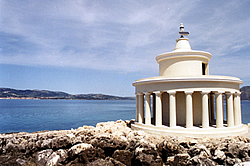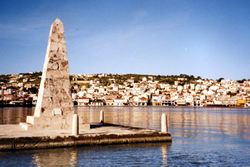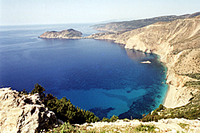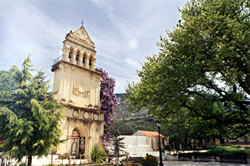The
blue and white paperback is everywhere. Eight years after its debut, Corelli's
Mandolin still crops up in airport bookstores, rural coffee shops, tattered
pages face-down on sandy beaches. So you'd expect the Greek island Kefalonia -
where Louis de Bernières set his best-selling book - to be a tacky theme
park of star-crossed Mediterranean love.
 | | Aghioi
Theodoroi, a squat white lighthouse outside Argostoli, recalling the 1820 British
original. |
Amazingly
enough, it's not. The hype breezed right by, leaving the turquoise waters and
forested slopes free of spin-off kitsch. A 'Corelli Cafe' pops up in one port
town, but otherwise it's easy to forget a blockbuster novel calls this home. The
area doesn't pander to the craze, while remaining gracious to the odd moon-struck
tourist. After all, why should a proud island redefine itself because of a foreigner's
book - let alone one inspired by a package holiday? The
movie's lukewarm reception helped keep the hordes away. The 2001 release starred
Nicolas Cage as the exuberant Italian soldier (sporting a much-ridiculed, vowel-fat
accent), Penelope Cruz and John Hurt. They
filmed on sets in the town of Sami, because the original location - the island's
capital Argostoli - disappeared in a cloud of rubble during the 1953
earthquake. Functional concrete cubes replaced much of the quaint Venetian architecture.
 | | The
obelisk crowning Argostoli's Drapano bridge, built by the British in 1813. |
Yet
busy, bustling Argostoli still has charm. Fishing boats dock at the palm-lined
wharf, where a wave mosaic meanders along the quay. Farmers buy supplies and sip
beer under neon lights. Village girls giggle along the pedestrian shopping avenue,
debuting their new heels before the pink, peeling tourists.
Other
- more critical - courtship rituals unfold here too. The endangered sea turtle
Caretta-Caretta mates in the Koutavos lagoon. The heavy females then heave out
of the sea and lay their eggs on Kefalonia's southern shores, especially at Minies,
Razakli and Skala.
The
bay is one of Greece's safest natural harbors. The low, stone arches of the Drapano
bridge skim above the water. The causeway, built by the British in 1813,
is crowned by a squat obelisk. Timid drivers may prefer the long way round, as
locals barrel across with the verve typical of Mediterranean motorists, never
batting at eyelash at near scrapes and collisions.
This
poker-faced resolve fits the Kefalonian stereotype. Lawrence Durrell described
them in The Greek Islands: "The inhabitants are kindly, if somewhat
brusque, and have a fine, long reputation for political intransigence and the
will to freedom that endeared them to the heart of Byron ... Here all is rough
and energetic."
 |
| Myrtos
Beach, famed for its azure waters and steep biscuit-colored cliffs. |
He
compared the locals' quirks to sinkholes just north of Argostoli. These katavothres channel seawater underground, fast enough to power several watermills. The current
races across the island, swirls through the dramatic underground in Melissani
Cave, near Sami, then plunges into the ocean. Durrell concluded that: "Everything
about the island and the island character is obstinately contrary-wise, even the
streams."
This
strength helped them survive World War II. After Mussolini's surrender, the Italian
soldiers who turned against the Nazis were massacred, alongside native resistance
fighters. Don't expect an accurate history lesson from de Bernières, who
painted an unnecessarily nasty view of the communists (and even the author derided
the sun-and-sex frivolity of the film). The 2001 documentary Are you Captain
Corelli? offers another glimpse of the war, through the recollections of Amos
Pampaloni, an Italian officer. His memoirs also inspired Marcello Venturi's novel White Flag over Kefalonia.
The
island's history is littered with oppression - from the Romans to pirates, Bonaparte
and the Imperial British - but the modern town is far from grim. The flip side
of the Kefalonian intractability is charm, as the English administrator, Sir Charles
Jacob Napier, responsible for much of the island's infrastructure noted: "The
merry Greeks," he wrote, "are worth all the other nations put together...
All their bad habits are Venetian; but their wit, their eloquence and their good
nature are their own."
 |
| The
bell tower of a vast church, dedicated to the island's patron Saint Gerasimos. |
And
good nature abounds there. The jolly Philharmonic Band often performs in the main
square, Plateia Vallianou. Pedestrian Lithostroto Street blazes at night, packed
with boutiques selling wild thyme honey, ceramics, leather goods, jewelry and
perfume. Kefalonians crowd into the open-air bars, sipping the local wines: red
Mavrodaphne, white Muscat and the pedigree vintage, Robolla (best with grilled
fish or cod pie).
The
frenzied ecstasy of the cinema, Corelli is nowhere to be found. Kefalonia has
better things to offer: free spirit, sense of contentment and integrity, even
in the grip of Hollywood.
IF
YOU GO...... |
Transport
Olympic
flies into Kefalonia's tiny airport, just 9km south of Argostoli. Unfortunately,
there's no public transport, but a taxi into Argostoli only costs €8 (226710-28545).
KTEL buses run from Athens: a mighty eight-hour journey. Prices hover around €25,
depending on the route. A 2 1/2 hour ferry connects Argostoli with Kyllini in
the Peloponnese. Other services dock at Sami, Poros, Pesada, Lixouri and Fiskardo.
Where
to stay
Budget travellers prefer Argostoli Beach Camping, 2km north of
town near the lighthouse (26710-23487; www.argostolibeach.gr). Hotel Tourist offers
more modern comfort overlooking the waterfront. Don't let the brazen name put
you off, this truly is a pleasant and welcoming establishment (26710-22510; doubles
€42). Or take a cue from the stars of Captain Corelli's Mandolin, who stayed
at the swish Hotel Ionian Plaza on Plateia Vallianou (26710-25581; doubles €62.50).
Where
to eat
Sip espresso and people-watch at popular Cafe da Capo (12 Vasileos
Georgiou). Kyani Akti serves decent appetizers in a superb location: atop a wooden
dock in the azure bay. If the waiters and the wind behave, it's magical (jetty
opposite the Marine Academy on the north end of the harbour; 26710-26680). Locals
prefer mellow vine-shaded Taverna Patsouras just down the street.
Information
Argostoli
has a Greek National Tourism Organisation (EOT) office on the harbour (Ioannis
Metaxa Street; open daily 7:30-14.30 and 17.00-20.00). Friends of the Ionian (www.foi.org.uk)
has a on-line travel shop and also provides information about Kefalonia's natural
history, culture, cuisine and trails. The website www.kefalonia-greece.biz/kefalonia.htm is extremely helpful. |
Headline
photograph of Fiskardo, Kefalonia, is courtesy of E.Papapanagopoylos / Greek
National Tourism Organization.
Greece
Home Page |